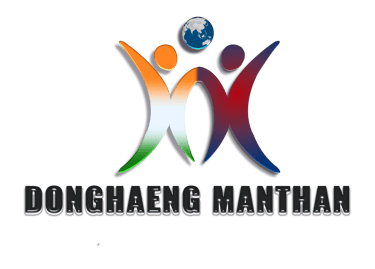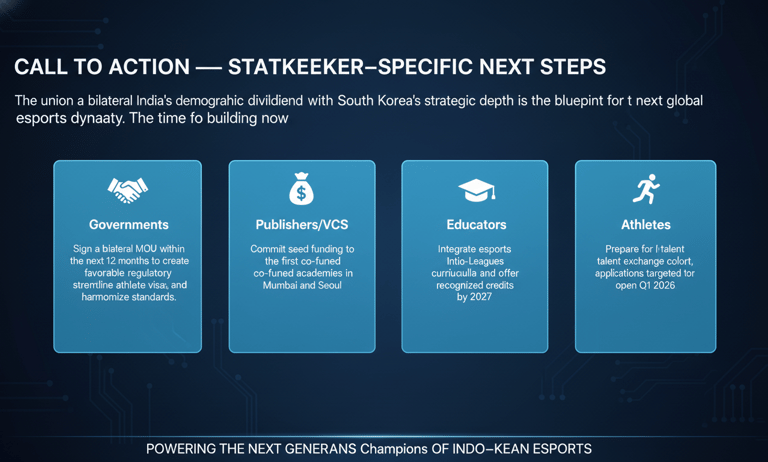eSports & Gaming Innovation
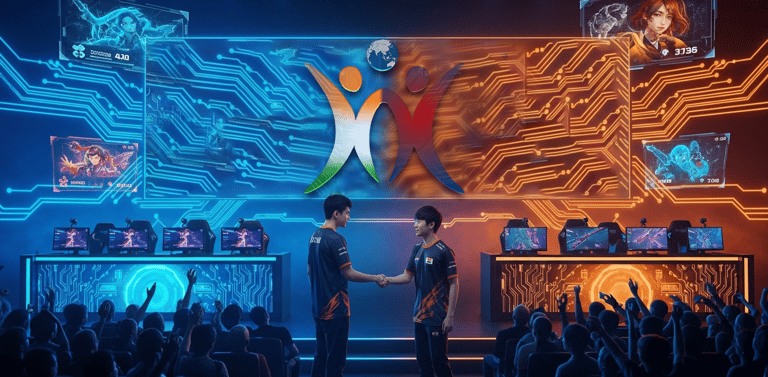

A Consolidated Blueprint for Bilateral Dominance
Hon’ble Prime Minister’s Address: New Law on Online Gaming – Safeguarding Families and the Future
You may have seen recently that during the current session of Parliament, our government introduced a new law related to online gaming. It is important for all teachers to be aware of this.
Unfortunately, gaming and gambling often get mixed up — what begins as gaming can easily turn into gambling. Therefore, the government has taken a major step by enacting this law. Many powerful groups did not want such a law to be passed, as it would impose restrictions on gambling in the country.
However, today we have a government with the political will and genuine concern for the bright future of our nation and our children. Ignoring all pressures and opinions, we have introduced laws to regulate online games.
Many of these online games were affecting our students — they were becoming involved in money-based gaming, investing more and more in hopes of earning quickly. I even received reports that in some families, when others went out, women at home also began playing such games on their mobile phones. This led to tragic incidents — suicides, debt, and financial ruin for entire families.

This addiction spreads like a kind of intoxication. The people behind these games design them in ways that trap users with attractive content and lure them into spending more. It became a serious concern for families everywhere.
That is why I say — while the law is necessary and now in place, it is equally important to create awareness among children. Parents may complain, but they cannot always change the situation because of the stress it creates at home. Teachers, however, can play a major role in this effort.
Along with the law, we have also ensured that harmful content does not reach children. I urge all teachers to raise awareness among their students about this issue.
Now, there are two distinct aspects here — gaming itself is not bad; gambling is harmful. Games that do not involve money are acceptable. In fact, you may know that certain forms of gaming have even been recognized as sports in the Olympic Games.
Developing talent and skills through such games is positive. But when it turns into addiction or obsession, destroying children’s lives, it becomes a matter of serious concern for the nation.
Our government aims to ensure that India’s youth establish a strong global presence in the gaming sector. There is great creative potential in India — we can develop many games based on our own stories and traditions. India can become a leader in the global gaming market.
We also have many traditional Indian games and cultural themes that can be transformed into engaging online games. Many startups are already doing remarkable work in this direction, and much more can be achieved.
If schools and colleges provide students with information about these opportunities, it can also open promising career paths for them in this growing field.
Executive Summary
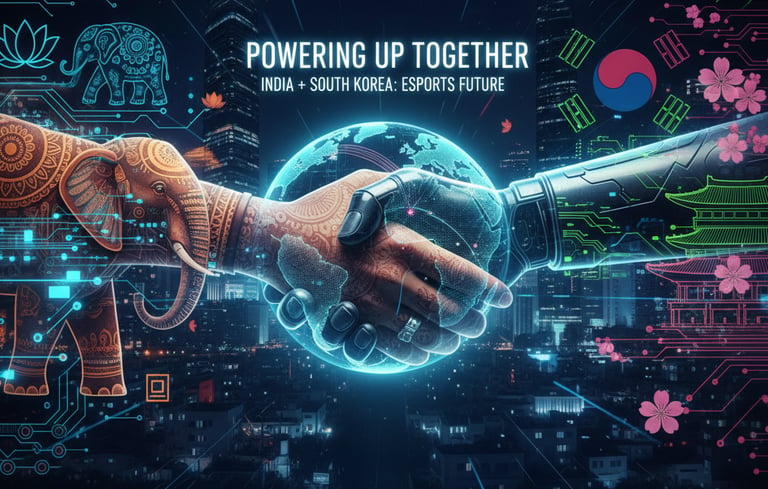

The global esports landscape stands at a critical inflection point. South Korea, the established powerhouse with two decades of professional gaming infrastructure and cultural integration, and India, the burgeoning mobile f irst giant with 641.2 million projected gamers by 2027, represent a once-in-a-generation partnership opportunity.
This blueprint outlines a comprehensive, self-sustaining esports talent development ecosystem that merges South Korea's institutional excellence, world-class infrastructure, elite coaching methodologies, and proven monetization models with India's explosive market growth (projected from $40M in 2022 to $140M by 2027), massive youth demographic, and emerging government support.
The partnership is not theoretical—collaborations like Krafton's KIGI incubator are already laying the groundwork. Success will create a cross-border dynasty that dominates competitive gaming, generates 200,000 300,000 skilled jobs, and positions both nations as global leaders in digital entertainment.
Strategic Rationale: India's 641.2 million gamers and $140M market (2027) provide scale and audience reach. South Korea's $237.3M mature market (2030) offers monetization expertise, infrastructure blueprints, and talent development frameworks. Together: a $377M+ ecosystem with exponential growth potential.
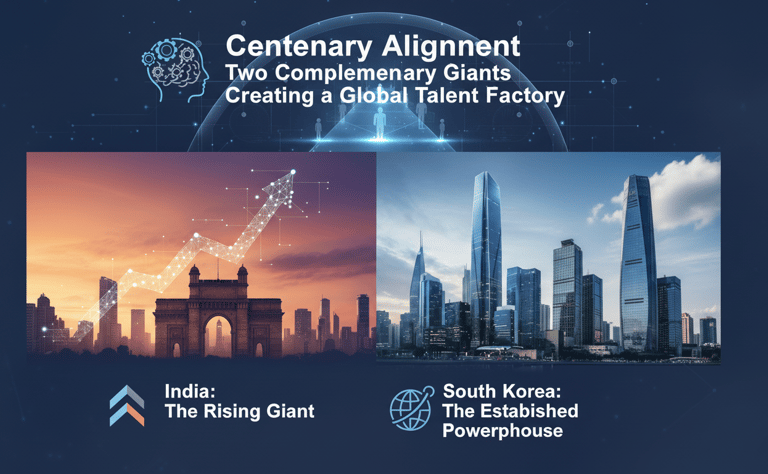

Vision & Value Proposition
Two Complementary Giants Creating a Global Talent Factory
India: The Rising Giant
Current State:
Gamer population: 444 million (2023) → 641.2 million (2027 projected)
Mobile-first market: 55.88% of gaming share
Esports market: $40M (2022) → $140M (2027)
Online gaming industry: $7.5B by FY2028
Average Revenue Per User (ARPU): $3.03 (critical constraint)
Growth driver: New user acquisition, 5G expansion, smartphone penetration.
Competitive Advantages:
Unprecedented demographic dividend (youth population)
Massive untapped talent pool Rapidly expanding manufacturing capabilities
Burgeoning government support and regulatory frameworks
Low-cost, high-volume market opportunity
Core Challenges:
Low ARPU ($3.03 vs. US $215, China $68)
Infrastructure lag relative to user growth
Limited esports cultural legitimacy
Fragmented regulatory environment
South Korea: The Established Powerhouse
Current State:
Esports market: $128.5M (current) → $237.3M (2030)
CAGR: 22.7% through 2030
Player base: Mature, smaller domestic base
Market driver: Diversified monetization, global expansion
Competitive Advantages:
Two decades of professional gaming ecosystem
World-class infrastructure (PC bangs, stadiums, academies)
Government-backed governance and institutional support
Deep cultural integration of esports as national sport
Elite coaching methodologies and "path-to-pro" models
Global recognition and brand prestige
Core Challenges:
Plateauing domestic player base
High operational costs
Loss of Chinese broadcasting rights (LCK losses: $29.8M over 3 years)
Market saturation requiring new growth vectors
The Legal Foundation:
India's Draft Gaming Rules 2025
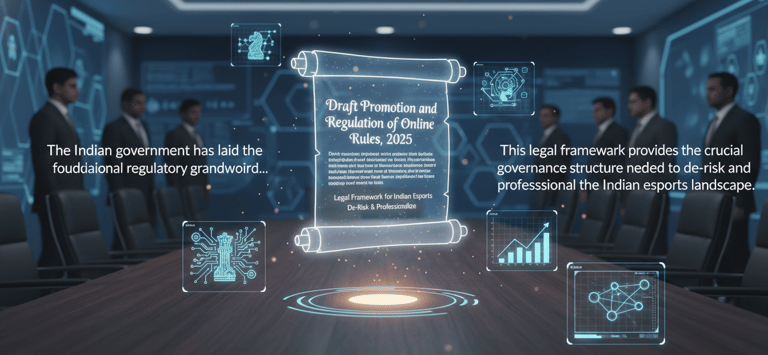

The Indian government has laid the foundational regulatory groundwork with the Draft Promotion and Regulation of Online Gaming Rules, 2025. This legal framework provides the crucial governance structure needed to de-risk and professionalize the Indian esports landscape.
Formal Recognition of Esports: The rules explicitly distinguish and provide a registration pathway for e-sports, administered by the Ministry of Youth Affairs and Sports, solidifying its status as a legitimate competitive sport.
Creation of a Regulatory Authority: The establishment of the Online Gaming Authority of India provides a central body for registration, grievance redressal, and enforcement.
Clear Registration Process: The rules outline a formal process for game publishers and tournament organizers to register their e-sports titles, bringing legitimacy and oversight.
National Registry: The creation of a National Online Social Games and E-sports Registry will provide a public list of certified and legitimate platforms.
Structured Grievance Redressal: A multi-tier system ensures user protection and fair play.
Comparative Market Snapshot
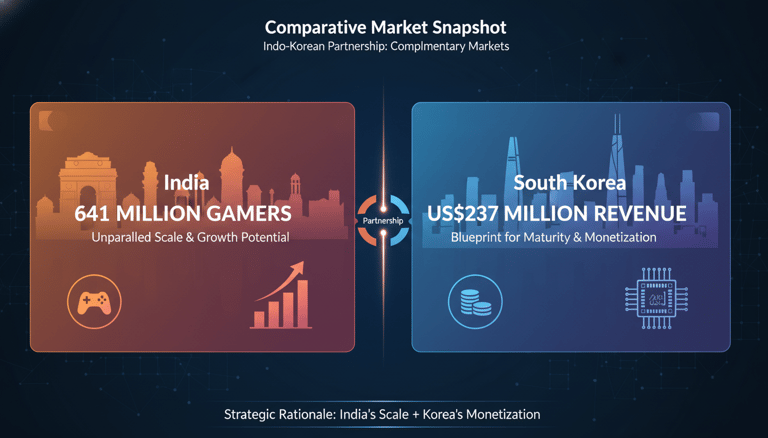

India’s 641 M gamers vs. Korea’s US$237 M revenue
The strategic rationale for an Indo-Korean partnership is rooted in the complementary nature of their respective markets. India offers unparalleled scale and growth potential, while South Korea provides a blueprint for maturity, professionalization, and high-value monetization.
India: Mobile-first growth outpacing infrastructure
India's esports market is defined by its rapid, mobile-first expansion. The market is projected to grow from $40 million in 2022 to $140 million by 2027, with the broader online gaming industry expected to hit $7.5 billion by FY2028. This growth is driven by a massive player base, set to reach 641.2 million by 2027, and the dominance of mobile gaming, which accounts for 55.88% of the market share.
However, this explosive growth comes with challenges. The Average Revenue Per User (ARPU) is currently a very low $3.03, a fraction of that in the US ($215) or China ($68), indicating that while the audience is vast, monetization strategies must be tailored for high-volume, low-cost transactions. Furthermore, the physical infrastructure, such as dedicated esports arenas, has not kept pace with the user growth.
South Korea: Mature revenue streams but plateauing domestic player base
South Korea is a global leader with a highly developed and mature esports market, valued at $128.5 million and projected to reach $237.3 million by 2030 with a strong CAGR of 22.7%. Its ecosystem is built on a foundation of proactive government support, world-class infrastructure, and deep cultural integration.
Despite its strengths, the market faces its own challenges. Even the premier League of Legends Champions Korea (LCK) has faced financial hurdles, accumulating 42.7 billion KRW (approx. $29.8 million) in losses over three years due to high operational costs and the loss of Chinese broadcasting rights. This indicates a need for new growth vectors and markets, which India's massive audience can provide.
Non-obvious synergy: Korean PC culture meeting India’s UPI micro-pay habits
The true synergy lies in combining the best of both worlds. South Korea's PC-centric, high-performance gaming culture and structured "path-to-pro" academy models can provide the strategic depth and training excellence India's raw talent needs. In return, India's ubiquitous and frictionless UPI payment system offers a solution to the monetization puzzle, enabling high-volume, low-cost transactions that can diversify revenue streams beyond the traditional sponsorship and media rights models that have proven challenging even in mature markets.
India
Gamer Population (2027 Proj.) = 641.2 Million
Esports Market Revenue = $140M (2027 Proj.)
Average Revenue Per User (ARPU) = $3.03
Primary Platform = Mobile (55.88% share)
Growth Driver = New user acquisition, 5G
South Korea
Gamer Population (2027 Proj.) = Mature, smaller base
Esports Market Revenue = $237.3M (2030 Proj.)
Average Revenue Per User (ARPU) = High (comparatively)
Primary Platform = PC-centric
Growth Driver = Diversified monetization, global expan
Strategic Implication
Gamer Population (2027 Proj.) = India provides the scale and audience for joint properties.
Esports Market Revenue = Korea offers monetization expertise to unlock India's revenue potential.
Average Revenue Per User (ARPU) = India's low ARPU necessitates a high-volume, micro-transaction model.
Primary Platform = Joint academies must create hybrid, mobile-first training modules.
Growth Driver = Collaboration accelerates growth for both markets.
Governance & Policy Alignment
Closing India’s five key gaps with KeSPA benchmarks
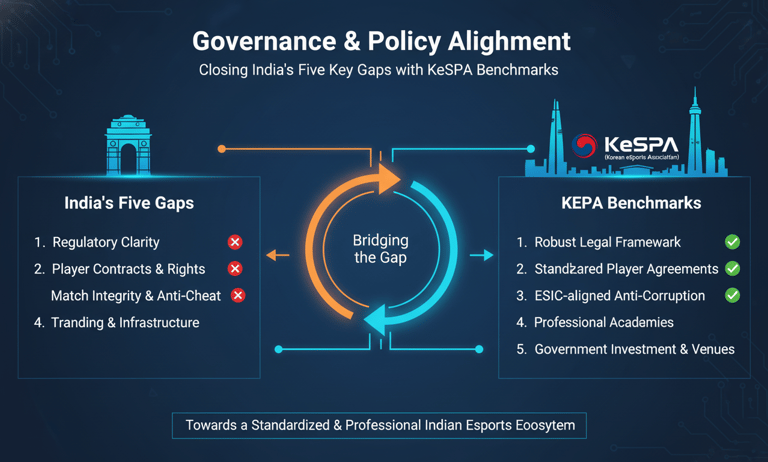

A sustainable bilateral ecosystem requires a harmonized and predictable regulatory environment. South Korea's mature governance, built over two decades, offers a proven blueprint for India's nascent framework.

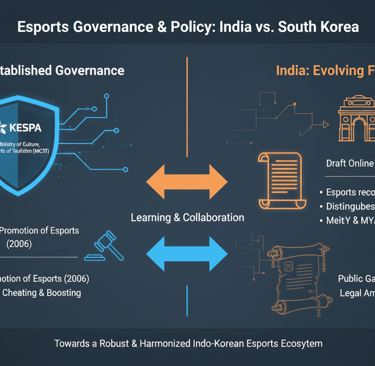
Current statutes & loopholes (India 2025 Bill vs. Korea 2006 Act)
South Korea's governance is anchored by the Ministry of Culture, Sports and Tourism (MCST) and the Korea e-Sports Association (KeSPA), a government-recognized body founded in 2000. This structure is solidified by modern legislation like the 'Act on the Promotion of Esports' (2006) and the 'Game Industry Promotion Act', which criminalizes cheating and boosting.
India's framework is evolving. The government's formal recognition of esports as a competitive sport in 2023 was a landmark step. The draft 'Promotion and Regulation of Online Gaming Bill 2025' aims to create structure by distinguishing skill-based esports from wagering, empowering MeitY and the Ministry of Youth Affairs and Sports to set guidelines. However, the system is fragmented and still hampered by archaic laws like the Public Gambling Act of 1867, creating legal ambiguity.
South Korea (KeSPA Model)
Regulatory Body = Centralized, government-recognized body (KeSPA) since 2000.
Legal Framework = Specific, modern laws ('Act on Promotion of Esports').
Player Protection = Mandated minimum salaries (approx. $20k/year) and 1-year contracts.
Competitive Integrity = Severe criminal penalties for hacking and boosting (jail time,fines).
Industry Data = Established monitoring and data collection.
India (Current State)
Regulatory Body = Fragmented across MeitY and Ministry of Youth Affairs & Sports.
Legal Framework = Relies on outdated gambling laws (Public Gambling Act, 1867).
Player Protection = Underdeveloped; no mandated minimums. Player welfare association lacks legal backing.
Competitive Integrity = Penalties often limited to in-game bans.
Industry Data = Significant scarcity of comprehensive industry data.
Key Gap & Recommendation
Regulatory Body = India needs a dedicated, KeSPA-like authority.
Legal Framework = Draft and pass modern, esports-specific legislation.
Player Protection = Adopt Korean standards for player contracts and welfare.
Competitive Integrity = Harmonize anti-cheat laws to the higher Korean standard.
Industry Data = Launch joint research initiatives for evidence-based policymaking.
Proposed Bilateral MoU: coach licence, athlete visas, anti-cheat harmonisation
To bridge these gaps, a bilateral Memorandum of Understanding (MoU) is the highest priority.
This agreement should focus on actionable areas:
Mutual Recognition of Coaching Licenses: Establish a framework to recognize coaching certifications from both countries, allowing Korean coaches to formally train Indian talent and vice-versa.
Harmonization of Standards: Work towards aligning standards on player contracts, anti-cheating protocols, and player welfare.
Talent Mobility: Create streamlined processes for athlete visas and exchange scholarships, allowing Indian players to train in Korean academies and compete in Korean leagues.
Joint Working Group: A joint working group was proposed during ministerial meetings to advance media and entertainment collaboration, which should be formalized to oversee these initiatives.
Fast-track wins: military-style athlete exemptions, GST clarity on digital goods
Beyond the MoU, there are immediate policy actions that can signal commitment and unlock value. Learning from South Korea's grant of military service exemption to gold-medal-winning athletes like Faker, India could explore similar recognitions to elevate the status of its top players. Additionally, providing clear guidance on the application of the 28% GST to esports-related digital goods and in-game purchases, distinguishing them from real-money gaming, would provide much-needed certainty for publishers and investors.
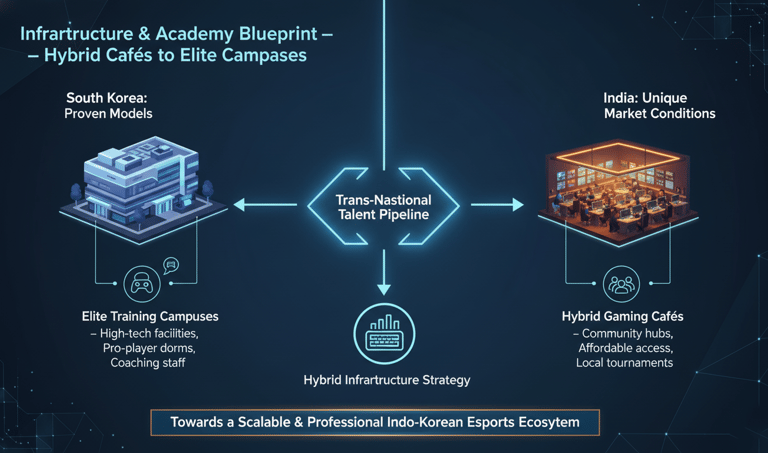

Infrastructure & Academy
Hybrid cafés to elite campuses
Building a trans-national talent pipeline requires a hybrid infrastructure strategy that adapts South Korea's proven models to India's unique market conditions.
Korean models: T1 Base Camp, Gen.G Global Academy metrics
South Korea's infrastructure is a multi-layered ecosystem. At the grassroots level, the 'PC bang' culture has historically served as an accessible, high-performance training ground and social hub, forming a crucial 'path-to-pro' pipeline. This is complemented by team-operated facilities like the T1 Base Camp, a 24/7 high-end PC room that doubles as a fan engagement hub.
At the elite level, dedicated esports stadiums like the Nexon Arena (a 1,683 sq. meter facility) and LoL Park have hosted major tournaments. The academy models are highly structured. The T1 Esports Academy (TEA) offers an intensive five-month 'Path to Pro' course, while the Gen.G Global Academy partners with schools to offer US-accredited education alongside esports training.
Indian adaptation: ₹99 UPI passes, multilingual curricula
A direct copy-paste of the PC-centric Korean model will not work in India. The adaptation plan must be mobile-first and cater to a low-ARPU environment.
Hybrid Gaming Cafés: Instead of pure PC bangs, India should develop hybrid venues that prioritize mobile gaming (with stable, high-speed Wi-Fi and charging stations) while also offering access to high-end PCs and consoles.
UPI-Friendly Monetization: These cafés should offer low-cost, UPI-enabled passes (e.g., hourly or daily passes for ₹99–₹129) to drive volume and accessibility.
Vernacular Content: To reach the 80% of gamers in diverse linguistic regions, all content, training materials, and interfaces must be multilingual.
Centralized Hub: The National Centre of Excellence for AVGC-XR (IICT) in Mumbai should be leveraged as a central node for curriculum development, research, and national-level infrastructure like arenas and labs.
Joint build plan: 2 centres (Mumbai, Seoul) with 14-week “Path-to-Pro” syllabus
A joint academy network should be established with two flagship centers, one in Mumbai and one in Seoul. The curriculum would be a hybrid, blending Korean strategic depth with Indian market relevance. It would mirror the 14-week training period of T1's 'Path to Pro' course, covering game theory, VOD review, and data analytics.
Crucially, it would also integrate sports science (nutrition, mental skills, ergonomics) and business training (tournament management, production, shoutcasting), as outlined in the Skyesports-IICT MoU. Staffing would include a mix of Korean and Indian experts, including former pro players as instructors.


CapEx & OpEx : PC-bang vs. Mobile café vs. Full arena
The financial model for infrastructure will vary significantly by type.
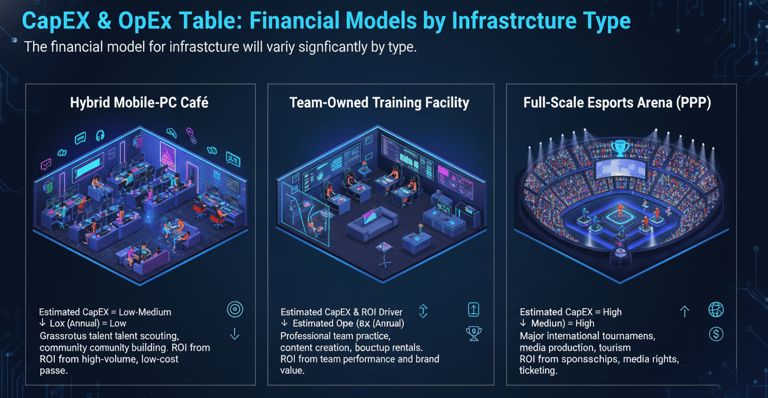

Hybrid Mobile-PC Café
Estimated CapEx = Low-Medium
Estimated OpEx (Annual) = Low
Primary Use Case & ROI Driver = Grassroots talent scouting, community building.
ROI from high-volume, low-cost passes.
Team-Owned Training Facility
Estimated CapEx = Medium
Estimated OpEx (Annual) = Medium
Primary Use Case & ROI Driver = Professional team practice, content creation,
bootcamp rentals. ROI from team performance and brand value.
Full-Scale Esports Arena (PPP)
Estimated CapEx = High
Estimated OpEx (Annual) = High
Primary Use Case & ROI Driver = Major international tournaments, media production,
tourism. ROI from sponsorships, media rights, ticketing.
Monetisation Playbook
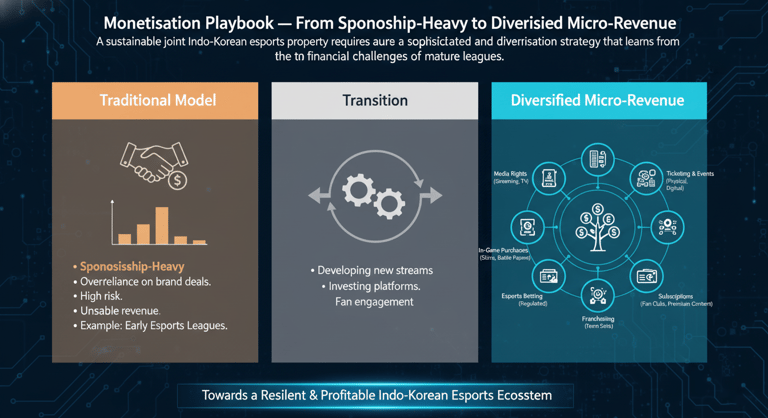

From sponsorship-heavy to diversified micro-revenue
A sustainable joint Indo-Korean esports property requires a sophisticated and diversified monetization strategy that learns from the financial challenges of mature leagues.
Lessons from LCK’s KRW 42.7 B loss
The League of Legends Champions Korea (LCK), one of the world's premier esports leagues, provides a cautionary tale. Despite immense popularity, with key matches drawing over 1.9 million viewers, the league accumulated losses of 42.7 billion KRW (approx. $29.8 million) over three years. The losses were primarily due to high fixed operational costs and the loss of lucrative Chinese broadcasting rights, highlighting the financial precarity of a model overly reliant on a few core revenue streams like sponsorships and media rights.
Indian ARPU reality & UPI micro-transactions
India's market presents a different paradigm. While the esports market is projected to reach $139.3 million in 2025, the Average Revenue Per User (ARPU) is a mere $3.03. This makes high-cost subscription or ticket models challenging. However, the widespread adoption of the Unified Payments Interface (UPI) creates a massive opportunity for high-volume, low-cost micro-transactions. Strategies must be built around UPI-friendly off-store payments for small in-game purchases, digital goods, and low-cost tournament passes (e.g., ₹10–₹129).
Joint league P&L forecast (table): break-even at Yr-3 with 35% revenue from digital goods
A hypothetical profit and loss (P&L) forecast for a joint league must be built on a diversified revenue mix.
Revenue Stream
Year 1 Projection
Sponsorships = 45%
Media Rights = 20%
Digital Goods & Microtransactions = 20%
Merchandise & Ticketing = 10%
Creator Commerce & Other = 5%
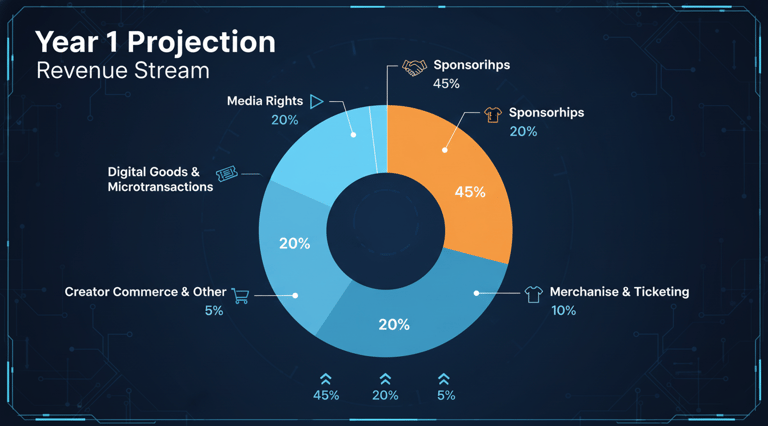


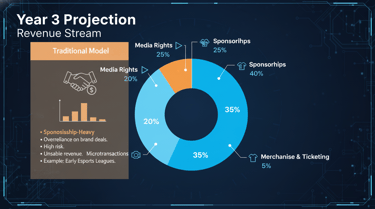
Year 3 Projection
Sponsorships = 40%
Media Rights = 25%
Digital Goods & Microtransactions = 35%
Merchandise & Ticketing = 5%
Creator Commerce & Other = 5%
Key Driver
Sponsorships = Securing marquee brands from both nations (e.g., Samsung, Jio, Hyundai).
Media Rights = Multi-platform deals (TV, OTT, global streaming).
Digital Goods & Microtransactions = UPI-enabled virtual gifts, fan passes, exclusive in-game items.
Merchandise & Ticketing = Physical and digital merchandise, tiered ticketing for live events.
Creator Commerce & Other = Revenue sharing with content creators, affiliate programs.
This model projects a path to break-even by Year 3, contingent on successfully scaling the high-volume digital goods category to 35% of total revenue.
Creator-commerce integration: S8UL + K-pop collaborations
A key pillar of the monetization strategy is the deep integration of content and commerce. This involves:
Leveraging Indian Creators: Partnering with influential Indian gaming organizations like S8UL, which has a proven track record of driving massive fan engagement and winning global content awards.
Cross-Cultural Collaborations: Creating unique monetization opportunities by merging the worlds of Indian esports and K-pop. This could include co-branded merchandise, in-game items designed by K-pop artists, and exclusive fan experiences.
Multi-Platform Media Distribution: Distributing content across a wide array of platforms, from traditional TV partners in India (like Star Sports) to OTT services (JioCinema) and short-form video apps (Reels, Shorts), to maximize reach and create diverse sponsorship inventory.
Cultural Legitimacy Engine
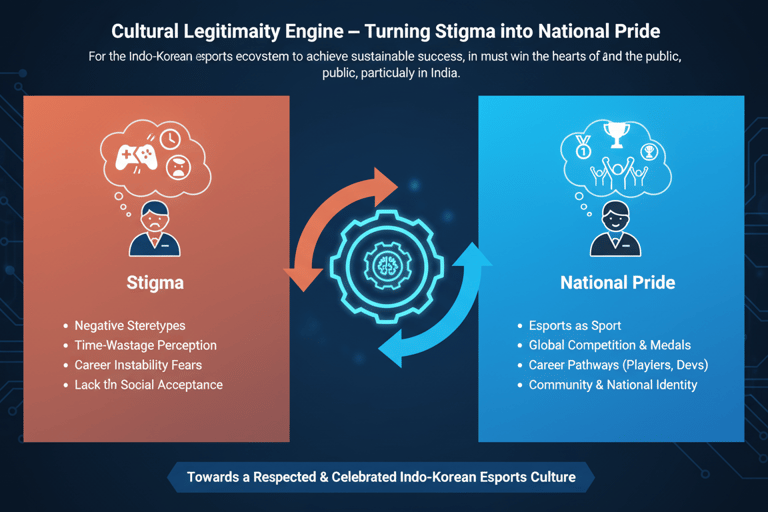

Turning stigma into national pride
For the Indo-Korean esports ecosystem to achieve sustainable success, it must win the hearts and minds of the public, particularly in India.
Korean playbook: celebrity athletes, TV rights, PC-bang social hubs
South Korea successfully built cultural legitimacy for esports over two decades through a concerted effort.
Celebrity Athletes: The creation of cultural icons like Lee 'Faker' Sang-hyeok, who is revered as a national hero, legitimized esports as a prestigious profession.
Mainstream Media: Cable channels like OGN (OnGameNet) began broadcasting esports tournaments as early as 2000, normalizing it as a form of mainstream entertainment.
Social Hubs: The pervasive 'PC bang' culture created physical spaces that served as social centers and crucial breeding grounds for talent.
Government Support: Early and sustained government backing, through the formation of KeSPA in 2000 and investment in dedicated stadiums, provided the institutional framework.
India strategy: school clubs, parental workshops, vernacular content
To replicate this success, India must adopt a culturally resonant strategy.
Grassroots Community Building: Promote the formation of esports clubs in schools and colleges and organize frequent, accessible municipal-level tournaments.
Parental Outreach: Conduct comprehensive educational campaigns, including workshops and testimonials from successful Indian pros, to showcase the career opportunities and skills developed through esports.
Vernacular Content: A multilingual approach is essential. Creating content, commentary, and educational materials in regional languages will make esports more accessible.
Content IP roadmap: bilingual reality show, behind-the-scenes series
Content is the most powerful tool for shifting cultural perceptions.
Original Content IPs: Build on the success of shows like 'Playground', a gaming reality show. Scaling such formats across multiple languages can create household names.
Humanize the Players: Emulate the sophisticated content models of Korean teams like T1 and Gen.G, using platforms like YouTube to produce behind-the-scenes series that showcase the dedication and discipline of the athletes.
Celebrate Indian Talent: Leverage the success of Indian content creators like S8UL to build a positive narrative and demonstrate the viability of careers in the gaming ecosystem.
Athlete Development Pipeline
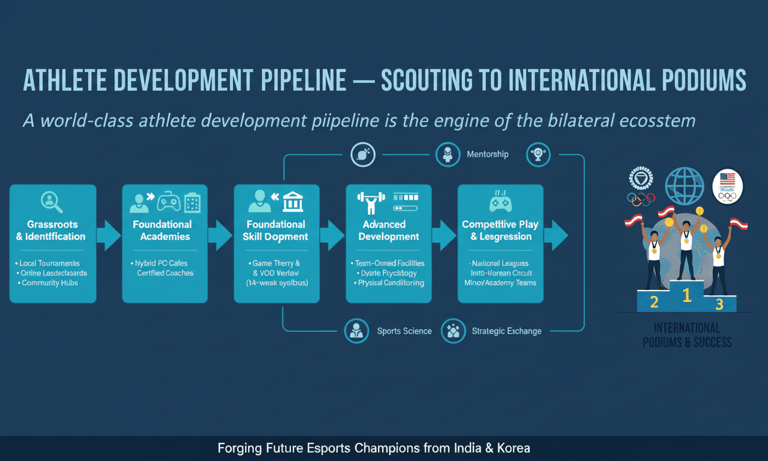

Scouting to international podiums
A world-class athlete development pipeline is the engine of the bilateral ecosystem.
Discovery: BGMI Showdown, Campus Tours, online ladders
The talent identification system is a multi-layered 'grassroots-to-global' pathway.
Elite Tournaments: Events like the BGMI Showdown (BMSD) and the BGMI International Cup (BMIC) serve as primary scouting grounds.
Grassroots Expansion: A Campus Tour is planned for 2025-26, specifically targeting Tier-2 cities and smaller towns.
Data-Driven Scouting: Traditional methods are supplemented by data analytics using tools like Mobalytics to analyze performance metrics.
Scouting Touchpoint
Campus Tours
Level = Grassroots
Target Audience = Students in Tier-2/3 cities
Key Outcome = Widening the talent pool, early identification.
Open Online Ladders
Level = Amateur
Target Audience = Aspiring individuals
Key Outcome = Merit-based discovery of raw talent.
BGMI Showdown (BMSD)
Open Online Ladders
Level = National Pro
Target Audience = National Pro
Key Outcome = National champion, direct global qualification.
BGMI International Cup (BMIC)
Level = International
Target Audience = Top 8 Indian teams vs. Korea/Japan
Key Outcome = International exposure, global qualification.
Performance science stack: ergonomics, SAQ, mental skills
The training protocol is a holistic, periodized model inspired by Korean academies. The T1 Esports Academy's five-month 'Path to Pro' course serves as a prime example. The regimen integrates performance science principles:
Physical Conditioning: Nutrition guidance, SAQ (Speed, Agility, Quickness) drills, strength and conditioning, and functional mobility development.
Mental Skills: Coaching focuses on developing a growth mindset, resilience, and effective team communication.
Health & Wellness: Protocols for managing training load, ergonomic assessments, and guidance on sleep.
Compliance: IGET tribunal adoption, anti-doping alignment with WADA
A robust coaching and compliance framework is essential for legitimacy.
Coaching Certification: Partnerships aim to establish structured coaching development and certification programs, creating a career pathway for former players.
Integrity & Dispute Resolution: Adoption of the International Games and Esports Tribunal (IGET) framework for independent dispute resolution.
Anti-Cheat & Anti-Doping: The joint pipeline must adopt the higher Korean legal standard and integrate anti-doping protocols aligned with WADA/NADA.
Strategic Partnership Frameworks
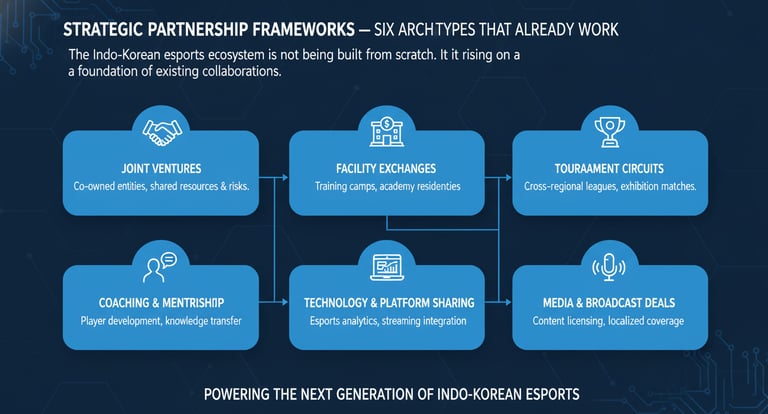

Six archetypes that already work
The Indo-Korean esports ecosystem is not being built from scratch. It is rising on a foundation of existing collaborations.
Accelerator/Incubator (KIGI)
This model focuses on nurturing early-stage talent and IP. The prime example is the KRAFTON India Gaming Incubator (KIGI), launched in 2023. The program provides mentorship and grants of up to $150,000 to promising Indian game development studios.
Strategic investment (Krafton→NODWIN)
This archetype involves a larger, established player taking a minority stake in a key local partner. The landmark example is Krafton's Rs 164 crore (approx. $22.4 million) investment in Indian tournament organizer NODWIN Gaming in 2021.
Co-developed IP (NODWIN + JSW)
This model involves partners collaborating to create and monetize new intellectual properties. NODWIN Gaming's partnership with JSW Sports aims to develop and market new gaming, esports, and cultural IPs.
Legal & operational checklist
A scalable partnership requires a robust legal and operational framework.
Framework Component with Description & Precedent
Dispute Resolution
Adoption of an independent body like the International Games and Esports Tribunal (IGET).
IP Ownership & Licensing
Clear legal agreements defining rights and revenue-sharing for co-developed games, leagues, and content.
League Governance
Established structures for rules, scheduling, and competitive integrity.
Data & Broadcast Rights
Clearly delineated contracts
Player Contracts
Standardized agreements covering salary, prize money, image rights, and welfare.
Operational Playbooks
Defined roles, responsibilities, and Service-Level Agreements (SLAs).
Risk & Mitigation Matrix


Regulatory, integrity, title-volatility
Building a bilateral esports ecosystem is a high-reward venture, but it comes with a complex set of risks.
Risk Category Regulatory Uncertainty
Risk Description
India's legal landscape is evolving. Sudden policy shifts can disrupt market stability.
Mitigation Strategy
Proactive Regulatory Engagement: Form strategic partnerships to engage with government stakeholders, advocate for clear policies, and ensure swift compliance.
Risk Category Competitive Integrity
Risk Description
Match-fixing and cheating are constant threats. A lack of severe penalties in India weakens deterrence.
Mitigation Strategy
Robust Governance Frameworks: Adopt independent, third-party dispute resolution mechanisms like IGET. Harmonize anti-cheat protocols to the higher Korean standard.
Risk Category Market & Title Volatility
Risk Description
The ecosystem is subject to the inherent volatility of esports titles. Publishers wield significant control.
Mitigation Strategy
Diversification and IP Development: Mitigate risk by diversifying across multiple game titles. Foster original IP development through incubators like KIGI.
Economic & Social Impact

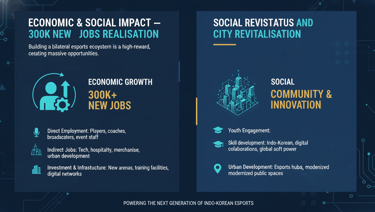
300K new jobs and city revitalisation
The creation of a bilateral Indo-Korean esports ecosystem is projected to deliver substantial economic and social returns.
Market-sizing scenarios 2026-30
The independent growth trajectories of both markets indicate a powerful synergistic potential. South Korea's mature market is projected to reach $237.3 million by 2030. India's esports market is forecasted to grow from $40 million in 2022 to $140 million by 2027. A combined ecosystem would likely accelerate these growth rates.
Job-creation by function
The Indian gaming industry is expected to create an additional 200,000 to 300,000 direct and indirect jobs in the coming years. A bilateral ecosystem would amplify this.
Job Category with Example Roles with Key Skill Requirement
Athlete & Performance
Professional Athlete, Coach, Team Manager, Data Analyst, Sports Psychologist
In-game mastery, strategic thinking, leadership, data analysis.
Event & Broadcast
Event Manager, Producer, Shoutcaster, Technical Director, Observer
Live production, project management, public speaking, technical expertise.
Content & Marketing
Content Creator, Social Media Manager, Brand Manager, PR Specialist
Creative storytelling, digital marketing, community management.
Business & Legal
Sponsorship Manager, IP Lawyer, Program Manager (Exchanges)
Sales, negotiation, international contract law, cross-cultural communication.
Urban development: esports arenas as tourism magnets
A bilateral partnership can be a powerful catalyst for urban development. South Korea offers a proven model where dedicated venues have become cultural hubs, driving tourism. For India, key cities like Mumbai, Delhi, and Bangalore can be transformed into premier esports hubs through the development of multi-purpose arenas via public-private partnerships.
Phased Implementation Roadmap — Pilot → Scale → Institutionalise
A structured, three-phase roadmap is essential to systematically build the ecosystem.
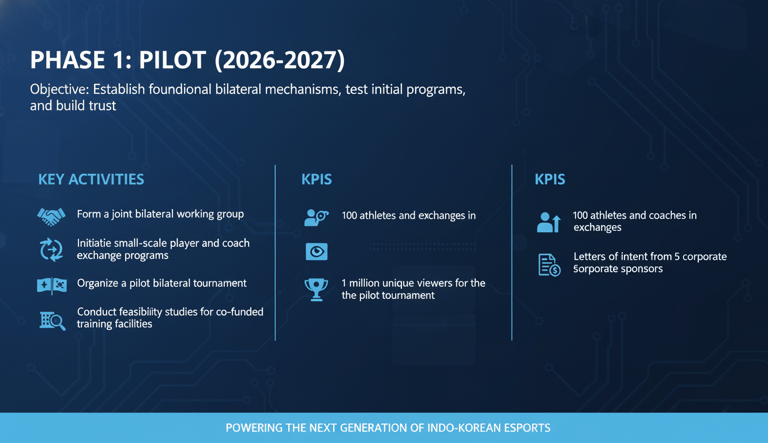

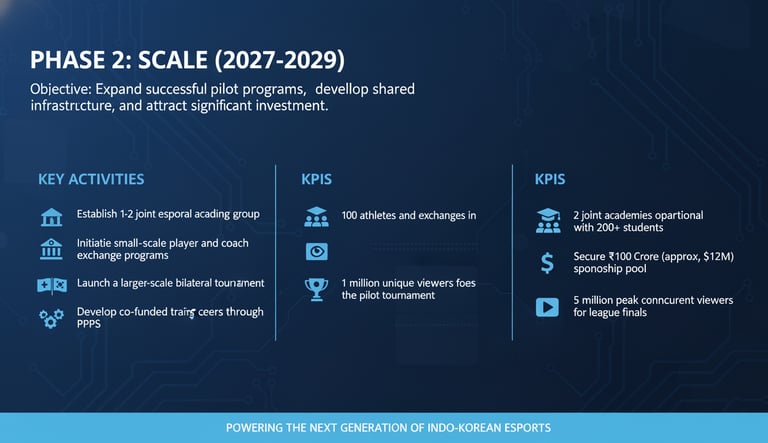



Phase 1: Pilot (2026-2027)
Objective: Establish foundational bilateral mechanisms, test initial programs, and build trust.
Key Activities: Form a joint bilateral working group; initiate small-scale player and coach exchange programs; organize a pilot bilateral tournament; conduct feasibility studies for co-funded training facilities.
KPIs: 100 athletes and coaches in exchanges; 1 million unique viewers for the pilot tournament; letters of intent from 5 corporate sponsors.
Phase 2: Scale (2027-2029)
Objective: Expand successful pilot programs, develop shared infrastructure, and attract significant investment.
Key Activities: Establish 1-2 joint esports academies; launch a larger-scale bilateral league; develop co-funded training centers through PPPs.
KPIs: 2 joint academies operational with 200+ students; secure a ₹100 Crore (approx. $12M) sponsorship pool; 5 million peak concurrent viewers for league finals.
Phase 3: Institutionalize (2029-2030)
Objective: Fully integrate the bilateral ecosystem and achieve a self-sustaining talent pipeline.
Key Activities: Establish a permanent bilateral esports council; create a seamless talent pipeline; develop esports tourism packages; fund joint R&D.
KPIs: Formal establishment of the bilateral council; the bilateral league achieves positive EBITDA; 10,000 international fans travel for a championship event.
Call to Action
Stakeholder-specific next steps
The union of India's demographic dividend with South Korea's strategic depth is the blueprint for the next global esports dynasty. The time for building is now.
Governments: Sign a bilateral MoU within the next 12 months to create favorable regulatory environments, streamline athlete visas, and harmonize standards.
Publishers/VCs: Commit seed funding to the first co-funded academies in Mumbai and Seoul.
Educators: Integrate esports into curricula and offer recognized credits by 2027.
Athletes: Prepare for the inaugural talent exchange cohort, with applications targeted to open in Q1 2026.
Connect
Join us in sustainable innovation efforts.
Engage
Support
© Donghaeng-manthan 2025. All rights reserved.
